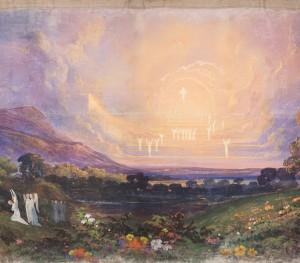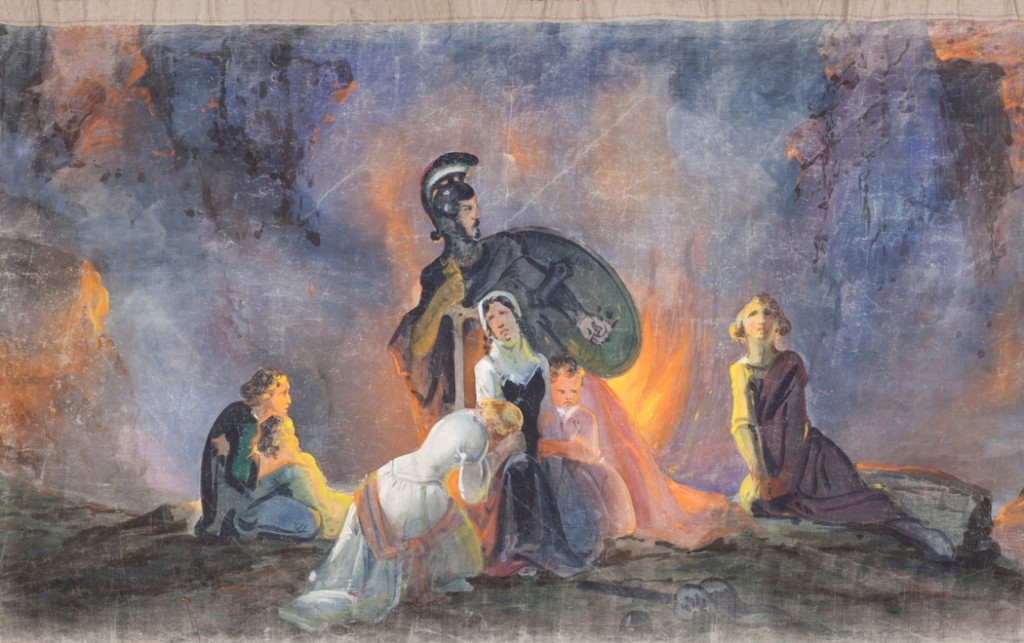After decades of obscurity….Panoramas are back in vogue, it seems. Late last month, the Saco Museum in Maine unveiled its Moving Panorama of Pilgrim’s Progress, which like The Panorama Of the Monumental Grandeur of the Mississippi Valley at the St. Louis Art Museum (which I wrote about here and here), has been conserved and is now ready for prime time.
 The Maine panorama, unlike the St. Louis one, was thought to be lost. As you’ll read below, it had disappeared from view for 100 years and was rediscovered only in 1996. It’s quite beautiful, judging by pictures, and was created by Edward Harrison May (1824-1887) and Joseph Kyle (1815-1863) and designed by some notable artists (see below).
The Maine panorama, unlike the St. Louis one, was thought to be lost. As you’ll read below, it had disappeared from view for 100 years and was rediscovered only in 1996. It’s quite beautiful, judging by pictures, and was created by Edward Harrison May (1824-1887) and Joseph Kyle (1815-1863) and designed by some notable artists (see below).
Now, “For the first time since the 1860s, the entire historic panorama—800 feet of vibrantly painted muslin canvas, in four sections—will be on view in two downtown locations, the Saco Museum and the historic Pepperell Mills.”  That comes after 15 years of research and restoration, partly funded with a Save America’s Treasures grant.
Here is its backstory, from the museum:
The Moving Panorama of Pilgrim’s Progress illustrates, in a way that no other work of art has done before or since, a moment when ideas about faith, art, and landscape all traveled along the same narrow highway in the course of American life. Also known as Bunyan’s Tableau, it was created in 1851 and presented to audiences nationwide throughout the second half of the 19th century. … Panoramas were presented by scrolling the massive canvas paintings across a stage, accompanied by narration and music. John Bunyan’s Pilgrim’s Progress, on which this panorama is based, was also a sensation in its time and beyond. Written in 1678 England, it achieved a peak of popularity in 19th-century America, where it became a huge influence upon literature and religion. The Moving Panorama of Pilgrim’s Progress was one of the most important moving panoramas in the United States, an exceptional example of this genre of painting that bridged high art and popular culture.
It was conceived by members of the National Academy of Design in New York, with designs contributed by Hudson River School masters Frederic Edwin Church, Jasper Cropsey, Daniel Huntington, and others.
In this way, it relates directly to the developing national school of landscape painting. After its final performance in York County, Maine, the Moving Panorama of Pilgrim’s Progress spent many years in a Biddeford barn and was ultimately given to the York Institute (now the Saco Museum) in 1896. The panorama was forgotten as the museum’s location moved from building to building, and was periodically closed for wartime uses, throughout the late 19th and early 20th centuries. It was not until 1996…that the panorama was rediscovered in the museum’s storage vault. It was this discovery that prompted the panorama’s partial conservation—approximately one fourth was treated—and exhibition tour in 1999. This current project completes the conservation work begun two decades ago, treating and exhibiting the panorama in its entirety and exploring innovative new strategies to make this immense masterpiece of 19th century American art accessible to audiences and scholars worldwide.
There’s much more here about the restoration in the press release, and the Saco Museum has also created a website for the panorama, where it has posted a film about the project, and a blog. The museum has also scheduled a day-long public symposium on September 21-22, 2012.
I’m hoping the piece, which is on view through Nov. 12, creates a lot of excitement in Maine. Saco is a small town, with fewer than 20,000 people, though it gets a lot of summer tourists.
Photo Credits: Courtesy of the Saco Museum

